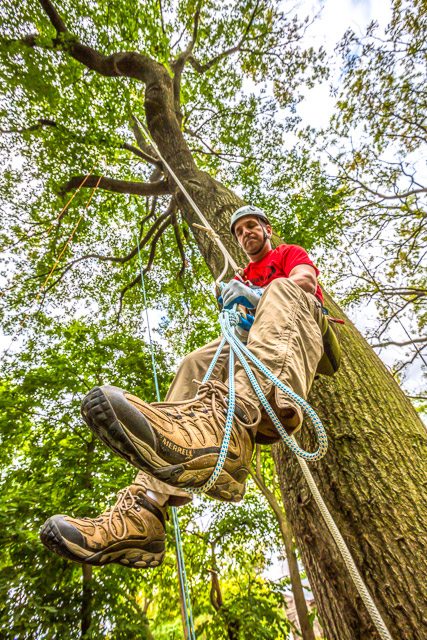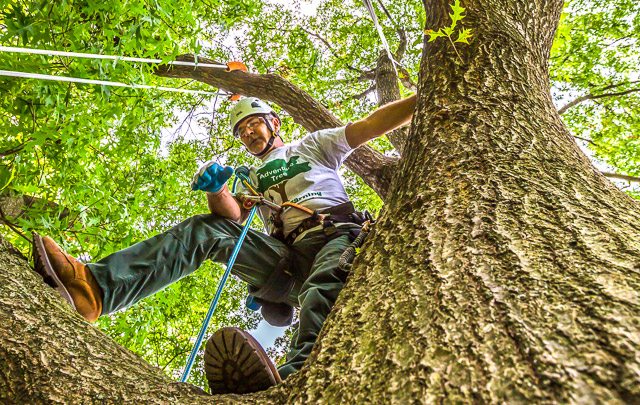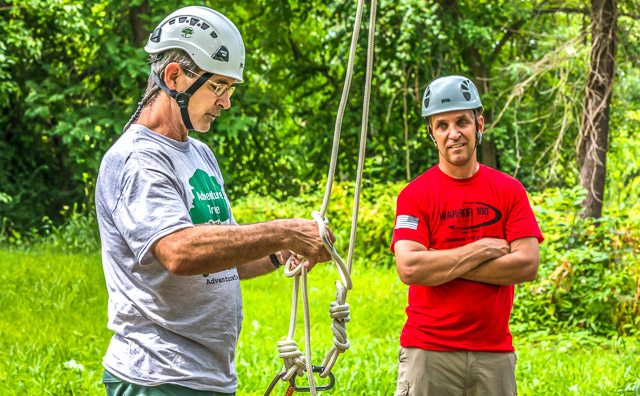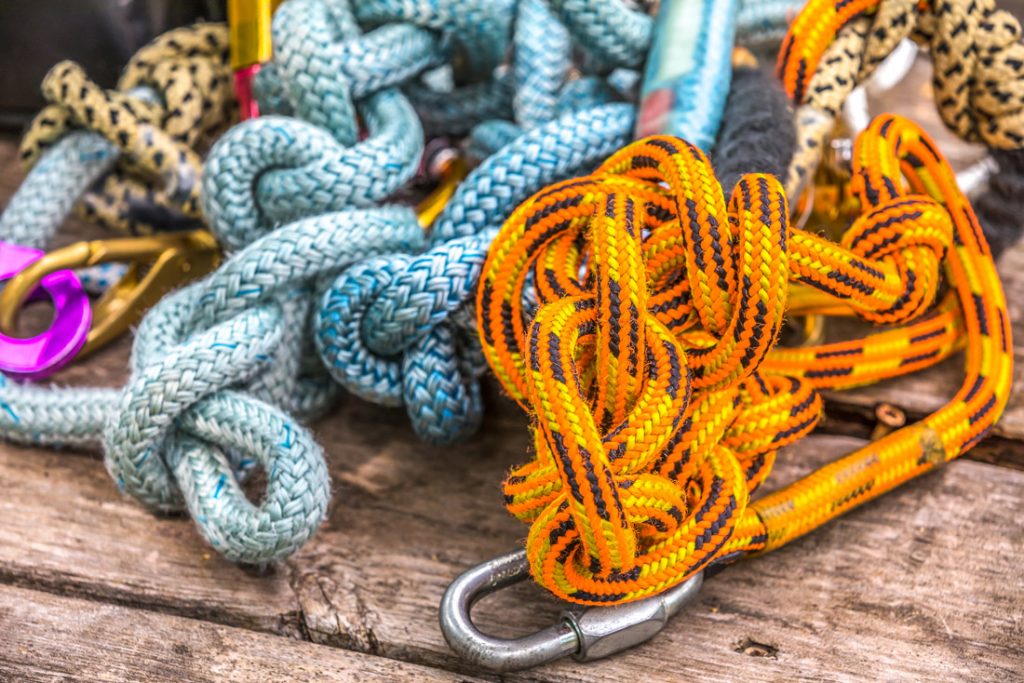This Yuletide, we invite you to take a break from the store aisles and give your loved ones the gift of experience. Offer them the chance to learn something new, try something they’ve always wanted to do, or create memories that will last longer than the snow on the ground.
We sent writer Matt Crossman out to test a few of the classes and adventure lessons offered around the state. He climbed trees, made cheese and lotion, and orientated in the wilderness with nothing more than a map, a compass, and a few friends.
As the holiday season approaches, we’ll be publishing all of these out-of-the-box ideas right here, so check back soon for more.
Climb Tall Trees
GIFT IDEA: Tree-climbing or other high-flying adventure lessons
PERFECT FOR: The adventuresome thrill-seeker you know and love … or those who like to challenge themselves in new and interesting ways
WHY: Sweat + exertion + new skill = big fun
Photos by Dennis Coello
The tree’s name is Willa. She is a majestic red oak in Ferguson, and right now I am standing on one of her branches 30 feet in the air. I am drenched in sweat, with rivulets trickling from under my helmet. I am wearing a harness, and ropes connected to it tie me to the tree. Those ropes supported me as I climbed up here. I know—or should know—that because of them, there is no way I could fall. Yet still, I hold Willa as tightly as I can.
I am on the first of multiple pitches—like the landings in a stairwell— to which my instructor, Guy Mott, and I plan to ascend as part of my tree-climbing lesson, and if I’m going to go to the next one, I need to let go of Willa. I simultaneously have zero interest in letting go and 100 percent interest in climbing higher.
Something has to give.
Guy (his first name rhymes with tree) asks how I’m doing. I tell him I’m nervous, which is an understatement. My fear of heights, which was absent as I climbed, has barged in, big time. As I cling to the tree, Guy gently tries to coax me into letting go. He wants me to trust the ropes.
But he doesn’t just tell me to trust them and expect me to do so. Instead, he encourages me to lean back, which will show me that the ropes will support me. Tentatively, I comply.
Fine, I think, the ropes work. I still ain’t letting go.
Guy and I talk about what I have to do to go higher. I will recount that conversation from memory, as even though my notebook and pen were in my pocket, I could not—would not—release my death grip on Willa to reach down to get them to take notes.
Here’s what I remember: Guy says something but I forget what it is because I’m listening to my inner voice as it asks, What was I thinking climbing this high?

When Guy, owner of Adventure Tree in St. Louis—the only adventure education company in the country with tree-climbing lessons as its core modality—was a boy, he heard the famous quote, “Youth is wasted on the young.” Those words have shaped his life ever since.
“I thought, that’s somebody looking back from deep into their life, saying, when I was young, I could have done more,” Guy says as he sits at a picnic table in the shade of Willa’s branches. “I just took that to heart. I thought, ‘I’m not going to waste my youth. I’m going to go out and do things.’”
When he was 17, Guy hitchhiked from the East Coast to the West Coast and back; it took two months. He drove a motorcycle at 140 miles per hour. He hiked the 486-mile Colorado Trail, long stretches of the Appalachian Trail, and all 48 of the 4,000-foot summits in the White Mountains of New Hampshire. He became a skydiving instructor and made 1,300 jumps.
All of that was for fun. For work, he designed software. After 30 years he decided that gratifying though that work may have been, it had kept him inside long enough. Nine years ago, Guy earned a master of education in adventure learning and started Adventure Tree with the slogan, “Have fun, learn, grow.”

Adventure Tree offers tree-climbing instruction to camps and schools so they can start their own courses. Guy also teaches safe climbing methods to utility workers and tree-service companies.
Although his tree-climbing courses focus on skills—how to climb the ropes, tie knots, get the ropes up in the tree (by using a 9-foot-tall slingshot that is as awesome as it sounds)—he teaches much more than that.
“I’m teaching people to climb, yes, but also to push and challenge themselves,” he says. “There’s something that accesses deep inside of people when they climb up in trees. I’ve felt it myself. I’ve experienced it. I’ve heard people echo it back to me. It’s very subtle, but you can feel it. It enriches your life. You learn something about trees and yourself.”
One thing Guy has learned about is fear. He sees it swathed across the faces of his students. Some people show up full of confidence and freak out halfway to the first pitch. Some people show up freaked out and somehow find the confidence to take them to the very top of Willa.
Others, like me, are a mix of the two. I climbed into the rope-harness contraption and pulled myself up to the first pitch without fear. The climbing motion involves a high step with my foot in a loop in the rope then pulling myself up with my arms. I could see the ropes working. But when I got to the first branch and stood on it, I froze. I stopped knowing the ropes were working and started wondering if they would.
I climbed by sight.
I needed to stand by faith.
I couldn’t do it.
I have a sketchy relationship with heights. When I was in first grade, my family drove the length of the Florida Keys. The bridges between each island terrified me. My memory says the other side of the two-lane bridge was an endless parade of nose-to-tail semis going 95 miles per hour, driving with their tires on the centerline and missing us by inches. I was certain our van would get hit by one of those trucks and go flying off the bridge.
When I drive over bridges now, I barely glance sideways. But it’s not just bridges; it’s heights in general. I have somehow kept every plane I’ve ever flown in aloft by gripping the armrest and digging my toes into the floor.
I often try to challenge that fear—I’ve gone parachuting, parasailing, paragliding, bungee jumping, and mountain hiking. I apply lessons learned by scaling mountains and jumping out of airplanes and climbing trees to the rest of my life. I own my own writing business, and for most of the past four years, I have been the sole breadwinner for my wife and two kids. That is scarier than all those other things combined, in large part because I have no choice. There are no ropes to keep me aloft, no branches to hold.
I have a choice on Willa. I could give up, and that thought crosses my mind. I look over at Guy, dangling a few feet to my left. He is smiling. I am grinding my molars to dust. The difference between my body language and his is the difference between Willa’s trunk and a cooked spaghetti noodle. I can’t talk myself into going any higher. But I can’t go down either.
 Some adventure instructors fully understand their adventure and know nothing about instructing. Guy has mastered both. He recognizes my distress, understands it, and doesn’t try to talk me out of it. After his instruction shows me I can trust the ropes, I manage to let go of Willa long enough to wrap a lanyard around her and connect it to myself, one carabiner on each hip of my harness. This is the proper procedure—Guy calls it one, two, one. I am always, always, always, tied in at least one way. After I connect the lanyard but before I disconnect my climbing rope, I am tied in twice. Even then, I barely let go.
Some adventure instructors fully understand their adventure and know nothing about instructing. Guy has mastered both. He recognizes my distress, understands it, and doesn’t try to talk me out of it. After his instruction shows me I can trust the ropes, I manage to let go of Willa long enough to wrap a lanyard around her and connect it to myself, one carabiner on each hip of my harness. This is the proper procedure—Guy calls it one, two, one. I am always, always, always, tied in at least one way. After I connect the lanyard but before I disconnect my climbing rope, I am tied in twice. Even then, I barely let go.
I unclip my climbing rope and hand it to Guy. He moves it higher in the tree—so I can climb higher if I ever decide I want to—and hands it back to me. I reconnect the rope to my harness (so I am again connected twice), disconnect the lanyard, take a deep breath, and start climbing again.
I high-step, pull, high-step, pull, high-step, pull, up, up, up some more. I stretch my hands and feet as far as they’ll go to my left to gain purchase on the next pitch. I pull myself over and sprawl on the branch.
I stand up.
I freeze again.
This time I thaw faster.
I do the lanyard dance again so Guy can move my rope. I perform a B.A.C.K. check—the safety routine Guy taught me in which I check the belt, anchor (the rope’s position in the tree), connectors, and knots.
Ten minutes later, I’m 10 feet higher in the tree—my third pitch—a full 55 feet up. I let go of Willa without Guy suggesting it first. “I couldn’t have done that 10 minutes ago,” I tell him.
I decide to quit here at the third pitch. I am in decent shape, but the stress of the climb, on top of the climb itself, has wiped me out. My hands shake. I struggle to open the carabiners. My left leg spasms up and down. And, yes, I’m still afraid. But that fear has turned practical.
 I start to slide down. I mess up the procedure, which causes the stopper knot that I tied in my rope on the way up to create a knot jam. I’m trapped 40 feet up, just dangling there.
I start to slide down. I mess up the procedure, which causes the stopper knot that I tied in my rope on the way up to create a knot jam. I’m trapped 40 feet up, just dangling there.
I was terrified half an hour ago when I was connected to the tree by the rope, lanyard, and my own death grip. Now all I have is the ropes, and I feel safe and secure. I finally wrench the knot loose and glide to the ground.
I’m exhilarated, radiating energy with “climber’s high.” I walk over to the picnic table to jot down notes. The adrenaline that has been rampaging through my bloodstream for the past hour is still on full go, so much so that I have no small motor skills. I can’t read a thing I wrote.
Related Posts
May 20, 1876
The St. Louis Globe merged with the St. Louis Democrat and, on this day, the first issue of the Globe-Democrat was sold.
March 11, 1980
The floating McDonalds on the St. Louis riverfront opened on this date.
Earthly Creations
They say that life is what happens while you’re busy making plans. We’re pretty sure you’d get no argument from Sandra Zak.


